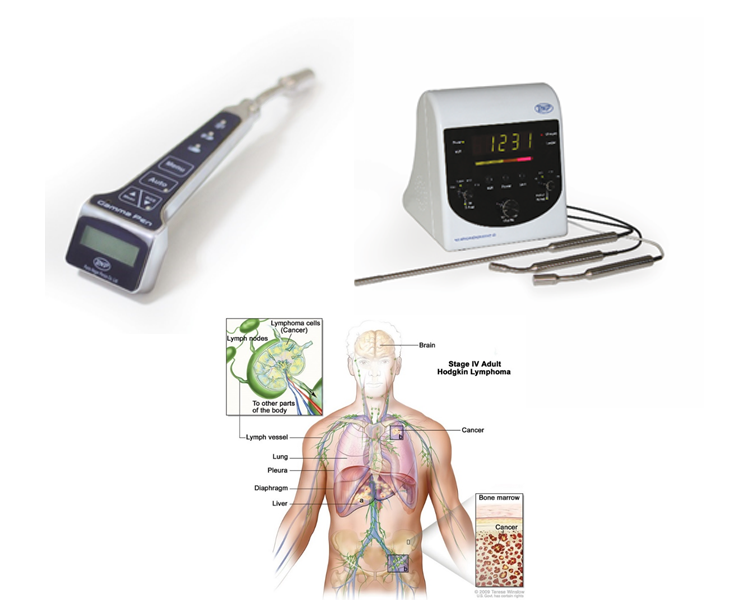SURGEOGUIDE II: Gamma Probe
Gamma Probe providing an easy-to-use small hand-held tool with the capability of detection and localization of sentinel lymph nodes not only in breast cancer but also for some masculine types of cancers where detection of sentinel nodes is mandatory.
Gamma probe system
A gamma probe is a handheld device used for intraoperative use following interstitial injection of a radionuclide, to locate regional lymph nodes by their radioactivity. It is used primarily for sentinel lymph node mapping and parathyroid surgery. Radionuclides which uses usually are Tc-99m, I-131 & F-18. Gamma probes can also be used in open surgery, laparoscopy and theroscopy (inside the body), and can be used externally (outside the body). Most use of gamma probes is in Sentinel Lymph Node Biopsy (SLNB) and Radio-Guided Occult Lesion Localization (ROLL). But these systems can be used in all cases where the detection of small points with high activity distribution, high sensitivity and resolution is desired.
General description
Due to high prevalence of breast cancer in females, there are annually lots of breast surgical operations for removal of malignant tumors. However, failure in discovery and removal of cancerous lymph nodes will lead to metastasis of cancer in the patient. Currently, there are some methods with different degrees of accuracy, cost, and ease to detect sentinel nodes. Amongst all of them, the most common and the most favorite device for surgeons is “Gamma Probe” providing an easy-to-use small hand-held tool with the capability of detection and localization of sentinel lymph nodes not only in breast cancer but also for some masculine types of cancers where detection of sentinel nodes is mandatory. We developed such a gamma probe system in two models: GammaPen and SURGEOGUIDE II.
Operation
The cancer metastasis, originating from the tumors, usually begins from the nearest lymph nodes. So, mapping and removal of cancerous lymph nodes especially the sentinel lymph node is of importance in cancer surgeries. The novel techniques in this field include Radio-Guided Surgeries in which the location of high concentration of the administered radiopharmaceutical in the patient body corresponds to the cancerous lymph nodes. After the injection of radiopharmaceutical, the surgeon first looks for presence or absence and the position of the cancerous lymph nodes using small-field-of-view gamma camera in the operation room. Then for precisely finding and removal of the lymph nodes, he/she applies gamma probe during the operation.
Clinical applications:
· Breast cancer
· Gynecological cancers (cervical, ovarian, uterine, vaginal and vulvar)
· Melanoma and other types of skin tumors
· Head & Neck
· Endocrine cancers (thyroid, parathyroid)
· Urology cancers (prostate, bladder, testicular, kidney and penile)
· Nuclear Medicine (localization of gamma labeled areas)
Gamma probe system: SURGEOGUIDE II model
Probe specifications:
· Three types of Probes: Large Tip, Small Tip, Endoscopic
· Length: 21 cm
· Tip Diameter: 16 mm (Large), 11 mm (Small), 10 mm (Endoscopic)
· Stainless Steel Body , Tungsten Collimator
· Crystal: CsI(Tl)
NEMA-NU3 standard test results:
· Sensitivity: ~2K cps/MBq @ 3 cm
· Shielding Efficiency: 99.6 % for Tc-99m
· Energy Resolution: <11% FWHM for Tc-99m
· Angular resolution: between 65° to 85°
· Local Resolution: <40 mm FWHM at 5 cm distance (For Large Probe)
System Specifications:
· 5 digit display
· Linear bar graph
· Sound modulated with count rate
· Scale select volume
· Isotope select volume
· Beep/FM sound
Gamma Probe catalogue


